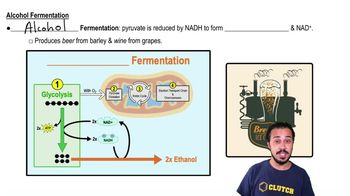Fermentation & Anaerobic Respiration definitions Flashcards
 Back
BackFermentation & Anaerobic Respiration definitions
1/15
Terms in this set (15)
- FermentationA metabolic process that regenerates NAD+ from NADH, allowing glycolysis to continue producing ATP in the absence of oxygen by using an alternative electron acceptor.
- Anaerobic Cellular RespirationA process where cells generate energy without oxygen by converting glucose into ATP, producing byproducts like lactic acid or ethanol, and regenerating NAD+ for glycolysis.
- Electron Transport ChainA series of protein complexes in the inner mitochondrial membrane that transfer electrons from NADH and FADH2 to oxygen, generating ATP through oxidative phosphorylation.
- NadhA molecule that carries electrons and is oxidized to regenerate NAD+ during fermentation, enabling glycolysis to continue in the absence of oxygen.
- Nad+An essential electron carrier in cellular respiration, it accepts electrons during glycolysis and fermentation, enabling ATP production in the absence of oxygen.
- GlycolysisA metabolic pathway that breaks down glucose into pyruvate, producing ATP and NADH, and occurs in the cytoplasm of cells, functioning with or without oxygen.
- PyruvateA key intermediate in cellular respiration, it is the end product of glycolysis and can be further metabolized in the Krebs cycle or reduced during fermentation to regenerate NAD+.
- Lactic Acid FermentationA metabolic process where pyruvate is reduced by NADH to form lactate and regenerate NAD+, enabling glycolysis to continue producing ATP in the absence of oxygen.
- LactateA byproduct of anaerobic respiration where pyruvate is reduced by NADH, regenerating NAD+ and allowing glycolysis to continue, producing a small amount of ATP.
- AtpA molecule that stores and transfers energy within cells, primarily produced during cellular respiration, and used to power various cellular processes.
- Pyruvate OxidationThe process where pyruvate is converted into acetyl-CoA, producing NADH and CO2, and linking glycolysis to the Krebs cycle in aerobic respiration.
- Krebs CycleA series of chemical reactions in mitochondria that generate ATP, NADH, and FADH2 by oxidizing acetyl-CoA derived from carbohydrates, fats, and proteins.
- ChemiosmosisThe process where ATP is synthesized using the energy from a proton gradient across a membrane, established by the electron transport chain during cellular respiration.
- Redox ReactionsA process involving the transfer of electrons between molecules, where one molecule is oxidized (loses electrons) and another is reduced (gains electrons), crucial for energy production in cells.
- OxidationThe process where a molecule loses electrons, often to oxygen, resulting in an increase in oxidation state.



